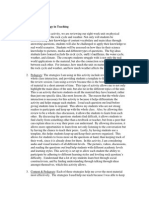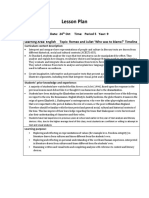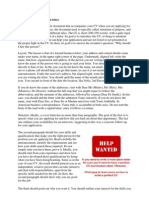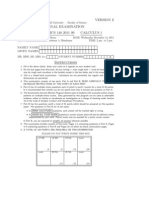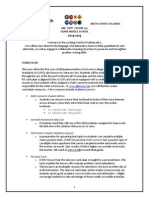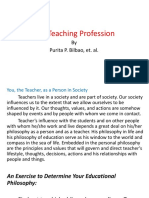0 ratings0% found this document useful (0 votes)
97 viewsForces Lesson 2 Katherine
Forces Lesson 2 Katherine
Uploaded by
api-107166048Lesson was designed to help students comprehend Newtons Iirst law oI inertia and the Iorces which act upon an object to slow it down, speed it down or change its direction. Students would be able to recognise the contribution oI science in concepts oI our everyday liIe. Students would conduct investigations and record data and then interpret the inIormation to draw conclusions about the types oI Iorces around us.
Copyright:
Attribution Non-Commercial (BY-NC)
Available Formats
Download as DOCX, PDF, TXT or read online from Scribd
Forces Lesson 2 Katherine
Forces Lesson 2 Katherine
Uploaded by
api-1071660480 ratings0% found this document useful (0 votes)
97 views4 pagesLesson was designed to help students comprehend Newtons Iirst law oI inertia and the Iorces which act upon an object to slow it down, speed it down or change its direction. Students would be able to recognise the contribution oI science in concepts oI our everyday liIe. Students would conduct investigations and record data and then interpret the inIormation to draw conclusions about the types oI Iorces around us.
Original Title
forces lesson 2 katherine
Copyright
© Attribution Non-Commercial (BY-NC)
Available Formats
DOCX, PDF, TXT or read online from Scribd
Share this document
Did you find this document useful?
Is this content inappropriate?
Lesson was designed to help students comprehend Newtons Iirst law oI inertia and the Iorces which act upon an object to slow it down, speed it down or change its direction. Students would be able to recognise the contribution oI science in concepts oI our everyday liIe. Students would conduct investigations and record data and then interpret the inIormation to draw conclusions about the types oI Iorces around us.
Copyright:
Attribution Non-Commercial (BY-NC)
Available Formats
Download as DOCX, PDF, TXT or read online from Scribd
Download as docx, pdf, or txt
0 ratings0% found this document useful (0 votes)
97 views4 pagesForces Lesson 2 Katherine
Forces Lesson 2 Katherine
Uploaded by
api-107166048Lesson was designed to help students comprehend Newtons Iirst law oI inertia and the Iorces which act upon an object to slow it down, speed it down or change its direction. Students would be able to recognise the contribution oI science in concepts oI our everyday liIe. Students would conduct investigations and record data and then interpret the inIormation to draw conclusions about the types oI Iorces around us.
Copyright:
Attribution Non-Commercial (BY-NC)
Available Formats
Download as DOCX, PDF, TXT or read online from Scribd
Download as docx, pdf, or txt
You are on page 1of 4
Lesson 2-Forces.
Year 8 Katherine High
MY REFLECTION OF THIS LESSON
The Iirst part oI the lesson did not run smoothly due to the projector not working so I was unable to
show the students the video clip in the lesson plan. The reason I had included the clip in the lesson was
to get students attention and Iocus. The video clip itselI was a Iun way to engage students in the lesson
so I could continue with the content. I did improvise by explaining concepts and drawing diagrams on
the board and went around later on and showed each group the video individually on a laptop. The Iirst
time I taught this lesson I used a video clip similar to this and Ielt that it drew the student`s interest. I
think that by not being able to show the students the clip in this lesson they were less engaged. In Iuture
lessons, I will continue to use this technique to gain attention.
This lesson was also disrupted due to students being taken out oI the classroom to complete a PoLT
survey. This became challenging because I had already selected groups Ior the students to work in some
cases many oI the team members oI each group were away Irom class Ior a signiIicant amount oI time.
This meant that students were coming into the classroom at all diIIerent times with no idea what they
were doing and subsequently they were very disruptive to other students. This also made it especially
hard to maintain behaviour in the classroom.
The outcomes oI this lesson were Ior students to be able to relate static electricity and inertia to their
prior knowledge oI Iorces. Students would be able to recognise the contribution oI science in concepts
oI our everyday liIe. Students would conduct investigations and record data and then process and
interpret the inIormation to draw conclusions about the types oI Iorces around us.
This lesson was designed to help students comprehend Newton`s Iirst law oI inertia and the Iorces which
act upon an object to slow it down, speed it up or change its direction etc. The second part oI the lesson
was to demonstrate the Iorces oI attraction between positively and negatively charged particles to
students.
Students were able to describe what a Iorce as a push or a pull; however they did not seem to be able to
relate the concept to static electricity or inertia. I used questioning throughout the lesson to determine iI
students understood what they were doing. Fewer students than I expected were able to identiIy the
relationship between Iorces and the activities. I think that in the case oI this class, Iurther discussion oI
the activities was required beIore the students undertook them, although I handed out a workbook with
step by step instructions and discussion questions Ior students, they all seemed unsure oI exactly what
they were expected to do. This caused a lot oI conIusion and ultimately students were disruptive and
disengaged.
Having students work in small groups and rotate around the room to complete the activities did not seem
to work in this classroom. Students seemed conIused with the rotation aspect and many did not work
cooperatively in groups. Many students were not writing observations or explanations on their
worksheets. I think this again comes back to me not giving these students enough instruction at the
beginning oI the lesson. I do however think that students became much more engaged in discussion
when I went around to each group individually at their stations and discussed what was happening.
Students were then able to Iill in answers to the discussion questions more readily.
The students in this class did not appear to have much prior knowledge oI the Iorces and I was wrong to
assume that because they undertook a similar topic in the previous school year that they would be able to
relate this inIormation to the activities I provided. I needed to spend more time reinIorcing concepts to
students and making my expectations clear, whilst gauging what they knew and what needed to be
Iocused on. When teaching this topic again to a group oI students similar to this one I would need to
Recognise the value oI regularly reIlecting on
their proIessional knowledge and practice
and develop strategies Ior reIlection
individually and collectively.
spend more time describing the relationships with Iurther video clips, demonstrations and explanation
beIore having students undertake the activities.
MENTOR TEACHER FEEDBACK:
The material and activities were appropriate and well organised Ior the lesson - consisting oI 6 mini-
investigations/experiments. A booklet was provided to each student which contained all activity
instructions and structured questions to answer. The rotational group work was a good idea and a
pedagogically sound decision to demonstrate a range oI concepts, along with maintaining student
enthusiasm and Iostering collaborative group dynamics.
Students seemed generally compliant when entering the classroom. The lesson commenced with
students being asked questions about things covered in the previous lesson - several students responded
and it also proved a successIul settling strategy in encouraging others to comply with expectations and
join in the discussion.
We knew in advance that there would be some disruption because oI 10 students at a time being
withdrawn to complete POLT survey. I believe this contributed to some unsettled behaviour with some
students and made things diIIicult Ior Jacqui who was trying to establish the direction oI the lesson,
instructions, etc, and just when she had almost Iinished, another group would go and a group would
return, Iorcing Jacqui to recap and restart instruction.
On the whole, I think the students appreciated the diIIerent concepts displayed through the activities.
As something to look at in the Iuture, I would like Jacqui to consider the importance oI establishing
behavioural boundaries and maintaining those with deliberate, pro-active rule-reminders and Iollow-
up/consequences, etc, as required. In particular this should be Ior insisting on silence beIore speaking,
as well as routine Iollow up Ior certain behaviours that might occur - and certainly Ior continued
deIiance and non-compliance with reasonable requests, work output expectations, etc. UnIortunately
with Middle Year aged students, management oI behaviour in a systematic/objective way can be just as
involved as preparing Ior the curriculum content. In time and with consistent application, students will
learn to operate within the behavioural boundaries are set Ior them, which will also have pay-oIIs in
their learning outcomes.
Josh Dean, Katherine High School
Lesson Plan
LESSON OB1ECTIVES:
Students will understand: What a force is and the concept of pushing and pulling forces and
their relationship to inertia and static electricity
Unit/Topic: Forces Lesson # 2
Strand(s): science Level: year 8
Time: 2 periods (65 mins each)
MATERIALS:
LESSON STRUCTURE:
Time Main Content: Teaching Approaches
10 min
20 mins
60 min
20 min
-Forces: What are forces
Introduce Inertia and static electricity
Show quick YouTube clip
http://www.youtube.com/watch?vSziVG51BGR8
Activities relating to inertia and static electricity
5 stations are set up and students are in groups of 2 or
three for activities. Students spend 5 minutes at each
activity and when completed, rotate to the next station.
1. Flick tricks
2. Catching coins
3. The spinning egg
4. Salt and Pepper
5. Bending Water
6. Balloon Magnet
Students answer questions and discuss answers to
questions.
Review oI previous lesson
Use a mind map or similar to
collaborate answers. Pose
questions such as what is a
Iorce/what is an example oI a
Iorce?
Class discussion, use board to
show examples and question
appropriately
ReIer to activity sheet Ior set
up oI activities. Teacher is
walking around classroom
asking questions about each
activity and helping students
to complete.
Students are required to Iill in
answers to discussion
questions on activity sheet
beIore they rotate to next
activity.
Students complete the
worksheet questions and are
asked to share their answers to
questions with the class and
discuss what they think is
happening in relation to each
activity. Activity sheets are to
be pasted into notebooks.
Copies oI activity sheet enough Ior one per student
13 20 cent coins
Playing card
I boiled egg
1 raw egg
Small plate
Table salt
Black ground pepper
Plastic ruler x2
Balloons
ASSESSMENT:
Classroom discussion oI questions Irom activity worksheets. Questioning students to attain their
understanding oI the topic.
You might also like
- Hegarty Lesson Plan Cep800Document7 pagesHegarty Lesson Plan Cep800api-273086278No ratings yet
- Best Lesson KasaokaDocument23 pagesBest Lesson Kasaokaapi-580714905No ratings yet
- Chapter 6 ReflectionDocument5 pagesChapter 6 ReflectionJaime FurstNo ratings yet
- Daily ReflectionsDocument4 pagesDaily Reflectionsapi-455790872No ratings yet
- Formal Classroom Observation #: 4 Post-Conference (Planning Conference) QuestionsDocument3 pagesFormal Classroom Observation #: 4 Post-Conference (Planning Conference) Questionsapi-525035372No ratings yet
- E01V Assignment 8Document8 pagesE01V Assignment 8kish0622No ratings yet
- Connected Lesson TemplateDocument29 pagesConnected Lesson Templateapi-295768366No ratings yet
- 785 - Life Science GsDocument4 pages785 - Life Science Gsapi-285356517No ratings yet
- Daily Unit ReflectionsDocument7 pagesDaily Unit Reflectionsapi-432453037No ratings yet
- Action Research Project - EvansDocument11 pagesAction Research Project - Evansapi-448622530No ratings yet
- Observation Sheet - Pinjarra High SchoolDocument8 pagesObservation Sheet - Pinjarra High Schoolapi-263206210No ratings yet
- Critical ReflectionsDocument3 pagesCritical Reflectionsapi-318188482No ratings yet
- Evaluation of A Lesson - Group ActivityDocument2 pagesEvaluation of A Lesson - Group Activityyogidaftary3No ratings yet
- Form 1 2 Aktas 1Document7 pagesForm 1 2 Aktas 1api-242938257No ratings yet
- Post Observation Document Dych 1Document2 pagesPost Observation Document Dych 1api-277678620No ratings yet
- Lesson Plan Life Cycle of A Pumpkin RevisedDocument8 pagesLesson Plan Life Cycle of A Pumpkin Revisedapi-340592260No ratings yet
- 9 Lesson 6Document6 pages9 Lesson 6api-372464959No ratings yet
- Second Grade Science LessonDocument15 pagesSecond Grade Science Lessonlionheart10131333% (3)
- Tpa 2Document11 pagesTpa 2api-242751197No ratings yet
- Reflection of LessonDocument9 pagesReflection of Lessonapi-260818426No ratings yet
- Short Lesson Plan Template Science Sink or Float Grade 1Document5 pagesShort Lesson Plan Template Science Sink or Float Grade 1api-643841683No ratings yet
- Lesson Plan PhotosynthesisDocument5 pagesLesson Plan Photosynthesissmily_face15No ratings yet
- Formal Observation ReflectionDocument3 pagesFormal Observation Reflectionapi-355496659100% (1)
- Sink or Float Science Lesson Lesson 1Document5 pagesSink or Float Science Lesson Lesson 1api-606131815No ratings yet
- Candidate Self Assessment of Video Taped LessonDocument6 pagesCandidate Self Assessment of Video Taped Lessonapi-296854004No ratings yet
- Evaluation of A Lesson - Group ActivityDocument2 pagesEvaluation of A Lesson - Group Activityyogidaftary3No ratings yet
- SocraticseminarDocument6 pagesSocraticseminarapi-271086058No ratings yet
- Lesson Plan 160204 Scientific MethodDocument7 pagesLesson Plan 160204 Scientific Methodapi-309206763100% (1)
- Fieldwork ObservationDocument6 pagesFieldwork ObservationYesenia Solis100% (1)
- Dice DIce Baby Activity and Practice Quiz Lesson Observation 3Document12 pagesDice DIce Baby Activity and Practice Quiz Lesson Observation 3Victoria WarrenNo ratings yet
- Lessonplans Task1 ArmbrusterDocument10 pagesLessonplans Task1 Armbrusterapi-234718869No ratings yet
- Lesson Review 5Document3 pagesLesson Review 5gggregorieNo ratings yet
- Inquiry Lesson (1) : Subject & Grade: Year 2 Inquiry/HASS Topic: Places of Significance ACDocument8 pagesInquiry Lesson (1) : Subject & Grade: Year 2 Inquiry/HASS Topic: Places of Significance ACapi-533606711No ratings yet
- AshleystreitmanDocument4 pagesAshleystreitmanapi-316235864No ratings yet
- Lesson Plan 3Document3 pagesLesson Plan 3api-267963208No ratings yet
- Blackte804sec005ss14inquiry ProjectDocument7 pagesBlackte804sec005ss14inquiry Projectapi-201492858No ratings yet
- 10 14 14 Pushes and Pulls LP - 3Document6 pages10 14 14 Pushes and Pulls LP - 3api-242467232No ratings yet
- Lesson Planning Form For Accessible Instruction - Calvin College Education ProgramDocument4 pagesLesson Planning Form For Accessible Instruction - Calvin College Education Programapi-340843498No ratings yet
- Reflections - Week 2Document4 pagesReflections - Week 2api-298663101No ratings yet
- Eced329-Lesson 2 ReviewDocument3 pagesEced329-Lesson 2 Reviewapi-213700287No ratings yet
- Week 1Document7 pagesWeek 1api-302003110No ratings yet
- Self AssessmentDocument7 pagesSelf Assessmentapi-273163050No ratings yet
- Observation SheetsDocument14 pagesObservation Sheetsapi-371750299No ratings yet
- Assignment 3 - ReflectionDocument5 pagesAssignment 3 - Reflectionapi-339908787No ratings yet
- State of Matter Lesson Reflection lp2Document4 pagesState of Matter Lesson Reflection lp2api-245081461No ratings yet
- CT Lesson ScienceDocument7 pagesCT Lesson Scienceapi-337799732No ratings yet
- PostobservationreflectionDocument2 pagesPostobservationreflectionapi-356058423No ratings yet
- Matter-Oobleck LessonDocument5 pagesMatter-Oobleck Lessonapi-281841554No ratings yet
- Teaching Statement Goals Course ReflectionDocument5 pagesTeaching Statement Goals Course Reflectionapi-249889728No ratings yet
- Video Taped LessonDocument8 pagesVideo Taped Lessonapi-302151781No ratings yet
- Claflin University School of EducationDocument4 pagesClaflin University School of Educationapi-216728214No ratings yet
- Daily Reflection 1Document4 pagesDaily Reflection 1api-295119035No ratings yet
- Four Levels of ReflectionDocument4 pagesFour Levels of ReflectionAmirah Izzati Nor AzamNo ratings yet
- Instruction and DeliveryDocument5 pagesInstruction and Deliveryapi-210118947No ratings yet
- Lesson Plan SDocument7 pagesLesson Plan Sapi-708462346No ratings yet
- Tws 6 ReflectionDocument4 pagesTws 6 Reflectionapi-122157048No ratings yet
- PostobservationreflectionDocument3 pagesPostobservationreflectionapi-300691216No ratings yet
- Seasons LessonDocument3 pagesSeasons Lessonapi-316732714No ratings yet
- Artifact 2 Lesson PlanDocument4 pagesArtifact 2 Lesson Planapi-509562997No ratings yet
- Using Segmentation in Data Collection and AnalysisDocument37 pagesUsing Segmentation in Data Collection and AnalysisLiwagonDionesioJrNo ratings yet
- Inclusive Education AssessmentDocument3 pagesInclusive Education AssessmentDean Brando Mansinadez Cinco100% (1)
- How To Write A Motivation LetterDocument21 pagesHow To Write A Motivation LetterMuhammad Faisol Haq0% (1)
- MATH-140 Quiz McGill UniversityDocument56 pagesMATH-140 Quiz McGill UniversityFarah Na'el MusharbashNo ratings yet
- Final Assignment 2-Lesson Plan AnalysisDocument13 pagesFinal Assignment 2-Lesson Plan Analysisapi-478705586No ratings yet
- The History of Women's College, TrivandrumDocument2 pagesThe History of Women's College, TrivandrumMurali Sankar V.K.100% (1)
- Gallery Walk Evidence For Competency 3cDocument17 pagesGallery Walk Evidence For Competency 3capi-428898897No ratings yet
- CAE Use of English 1-TESTDocument5 pagesCAE Use of English 1-TESTMaria AgapeNo ratings yet
- Administrative Assistant Office Manager in Hartford CT Resume Karen RealeDocument1 pageAdministrative Assistant Office Manager in Hartford CT Resume Karen RealeKarenRealeNo ratings yet
- Celta Lesson Plan TP 3Document5 pagesCelta Lesson Plan TP 3mastro100100% (2)
- Chelmsford Open Day Z CardDocument4 pagesChelmsford Open Day Z Cardgimbelmaksim494No ratings yet
- Joann MyersDocument2 pagesJoann Myersapi-322627083No ratings yet
- Volleying LessonDocument3 pagesVolleying Lessonapi-285176310No ratings yet
- Classroom DiscourseDocument3 pagesClassroom Discoursechahinez bouguerraNo ratings yet
- EmceeDocument3 pagesEmceeUmmycalsum British SumndadNo ratings yet
- Draft HMEF5063 - V2 Guide - CounselingDocument15 pagesDraft HMEF5063 - V2 Guide - CounselingThenaamutan AmuthanNo ratings yet
- Constitution of BRAC University Alumni AssociationDocument7 pagesConstitution of BRAC University Alumni AssociationSunjib Singha100% (3)
- Book Extension Activity - Lesson PlanDocument2 pagesBook Extension Activity - Lesson Planapi-459689790No ratings yet
- Math Syllabus 2014-15Document3 pagesMath Syllabus 2014-15api-246588143No ratings yet
- CSU-ACLU Email ThreadDocument12 pagesCSU-ACLU Email ThreadMichael_Lee_RobertsNo ratings yet
- Today: HOME Is Where The IsDocument13 pagesToday: HOME Is Where The IsHoly Names UniversityNo ratings yet
- CarterGreenbergWalker AEFP PDFDocument32 pagesCarterGreenbergWalker AEFP PDFFranchesca LansanganNo ratings yet
- LESSON PLAN by Whitley Starnes 5E Science Lesson: Food Chain Time: 30 Minutes Grade Level: 5 Academic StandardDocument9 pagesLESSON PLAN by Whitley Starnes 5E Science Lesson: Food Chain Time: 30 Minutes Grade Level: 5 Academic StandardBelleMichelleRoxasJaraulaNo ratings yet
- If You Teach or Write 5Document32 pagesIf You Teach or Write 5Mystique CarreraNo ratings yet
- Lecture 1 What Is SBARDocument24 pagesLecture 1 What Is SBAREddie Fetalvero100% (1)
- Portfolio Artifact 1 - Personal Cultural Project Edu 280Document10 pagesPortfolio Artifact 1 - Personal Cultural Project Edu 280api-313833593100% (1)
- The Teaching ProfessionDocument17 pagesThe Teaching ProfessionRJ Fraginal100% (1)
- Sample ScriptDocument2 pagesSample Scriptmacyselena100% (1)
- Bowie "Frazer" CampbellDocument2 pagesBowie "Frazer" Campbellapi-253571986No ratings yet
- Caste System Lesson PlanDocument4 pagesCaste System Lesson Planapi-3187948240% (1)
